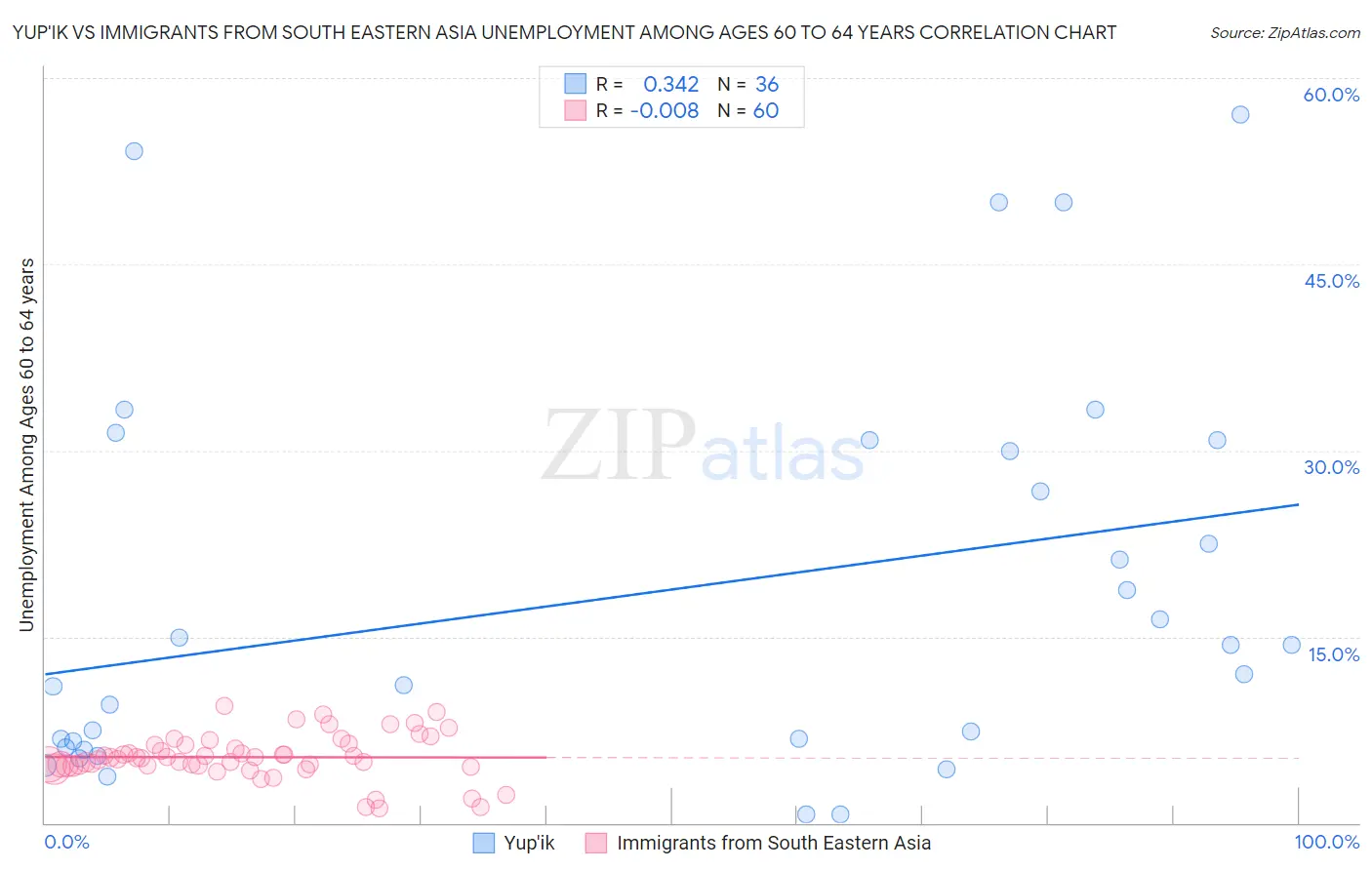Yup'ik vs Immigrants from South Eastern Asia Unemployment Among Ages 60 to 64 years
COMPARE
Yup'ik
Immigrants from South Eastern Asia
Unemployment Among Ages 60 to 64 years
Unemployment Among Ages 60 to 64 years Comparison
Yup'ik
Immigrants from South Eastern Asia
11.9%
UNEMPLOYMENT AMONG AGES 60 TO 64 YEARS
0.0/ 100
METRIC RATING
347th/ 347
METRIC RANK
4.9%
UNEMPLOYMENT AMONG AGES 60 TO 64 YEARS
13.1/ 100
METRIC RATING
215th/ 347
METRIC RANK
Yup'ik vs Immigrants from South Eastern Asia Unemployment Among Ages 60 to 64 years Correlation Chart
The statistical analysis conducted on geographies consisting of 38,589,924 people shows a mild positive correlation between the proportion of Yup'ik and unemployment rate among population between the ages 60 and 64 in the United States with a correlation coefficient (R) of 0.342 and weighted average of 11.9%. Similarly, the statistical analysis conducted on geographies consisting of 441,714,524 people shows no correlation between the proportion of Immigrants from South Eastern Asia and unemployment rate among population between the ages 60 and 64 in the United States with a correlation coefficient (R) of -0.008 and weighted average of 4.9%, a difference of 141.3%.

Unemployment Among Ages 60 to 64 years Correlation Summary
| Measurement | Yup'ik | Immigrants from South Eastern Asia |
| Minimum | 0.70% | 1.2% |
| Maximum | 57.1% | 9.4% |
| Range | 56.4% | 8.2% |
| Mean | 18.5% | 5.3% |
| Median | 13.2% | 5.3% |
| Interquartile 25% (IQ1) | 6.3% | 4.6% |
| Interquartile 75% (IQ3) | 30.4% | 6.3% |
| Interquartile Range (IQR) | 24.1% | 1.6% |
| Standard Deviation (Sample) | 15.8% | 1.8% |
| Standard Deviation (Population) | 15.6% | 1.8% |
Similar Demographics by Unemployment Among Ages 60 to 64 years
Demographics Similar to Yup'ik by Unemployment Among Ages 60 to 64 years
In terms of unemployment among ages 60 to 64 years, the demographic groups most similar to Yup'ik are Inupiat (9.6%, a difference of 24.4%), Alaskan Athabascan (8.4%, a difference of 42.1%), Alaska Native (7.6%, a difference of 56.3%), Immigrants from Yemen (6.8%, a difference of 74.6%), and Aleut (6.8%, a difference of 75.9%).
| Demographics | Rating | Rank | Unemployment Among Ages 60 to 64 years |
| Immigrants | Dominican Republic | 0.0 /100 | #333 | Tragic 6.0% |
| Puerto Ricans | 0.0 /100 | #334 | Tragic 6.1% |
| Vietnamese | 0.0 /100 | #335 | Tragic 6.1% |
| Kiowa | 0.0 /100 | #336 | Tragic 6.2% |
| Navajo | 0.0 /100 | #337 | Tragic 6.3% |
| Arapaho | 0.0 /100 | #338 | Tragic 6.3% |
| Tlingit-Haida | 0.0 /100 | #339 | Tragic 6.4% |
| Pueblo | 0.0 /100 | #340 | Tragic 6.7% |
| Yuman | 0.0 /100 | #341 | Tragic 6.8% |
| Aleuts | 0.0 /100 | #342 | Tragic 6.8% |
| Immigrants | Yemen | 0.0 /100 | #343 | Tragic 6.8% |
| Alaska Natives | 0.0 /100 | #344 | Tragic 7.6% |
| Alaskan Athabascans | 0.0 /100 | #345 | Tragic 8.4% |
| Inupiat | 0.0 /100 | #346 | Tragic 9.6% |
| Yup'ik | 0.0 /100 | #347 | Tragic 11.9% |
Demographics Similar to Immigrants from South Eastern Asia by Unemployment Among Ages 60 to 64 years
In terms of unemployment among ages 60 to 64 years, the demographic groups most similar to Immigrants from South Eastern Asia are Immigrants from Russia (4.9%, a difference of 0.050%), Cajun (4.9%, a difference of 0.060%), Korean (4.9%, a difference of 0.070%), Immigrants from Singapore (4.9%, a difference of 0.080%), and Eastern European (4.9%, a difference of 0.090%).
| Demographics | Rating | Rank | Unemployment Among Ages 60 to 64 years |
| German Russians | 16.8 /100 | #208 | Poor 4.9% |
| Sierra Leoneans | 16.5 /100 | #209 | Poor 4.9% |
| Cherokee | 16.1 /100 | #210 | Poor 4.9% |
| Blackfeet | 15.7 /100 | #211 | Poor 4.9% |
| Moroccans | 15.0 /100 | #212 | Poor 4.9% |
| Eastern Europeans | 14.3 /100 | #213 | Poor 4.9% |
| Immigrants | Russia | 13.7 /100 | #214 | Poor 4.9% |
| Immigrants | South Eastern Asia | 13.1 /100 | #215 | Poor 4.9% |
| Cajuns | 12.3 /100 | #216 | Poor 4.9% |
| Koreans | 12.2 /100 | #217 | Poor 4.9% |
| Immigrants | Singapore | 12.0 /100 | #218 | Poor 4.9% |
| Immigrants | Brazil | 11.7 /100 | #219 | Poor 4.9% |
| Ottawa | 11.6 /100 | #220 | Poor 4.9% |
| Ugandans | 10.5 /100 | #221 | Poor 4.9% |
| Brazilians | 10.1 /100 | #222 | Poor 5.0% |